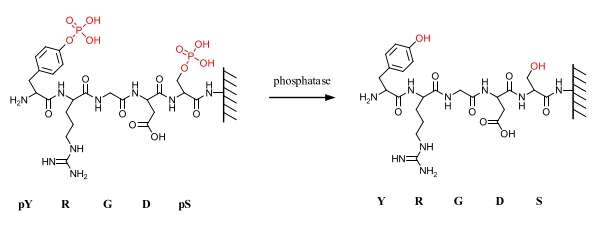Responsive materials and surfaces
Functionality of a biomaterial or biomedical device is not only determined by static interactions. Biological systems are dynamic and represent a complex, changing environment. To mimic these properties, responsive materials and surfaces are employed.
We aim to design responsive materials and surfaces that allow improved integration or interaction with a biological environment. Currently we focus mainly on two types of stimuli, light and enzymes. Light is suitable for triggering changes in the properties of the biointerface rapidly and non-invasively. Enzymes are relatively new triggers for stimuli responsive materials; they are highly attractive as they enable tighter integration of artificial materials with living tissue as they are intrinsically used to regulate biological processes.
The fabrication of responsive materials in our lab involves both organic synthesis in solution and reactions on solid surfaces. The materials we focus on are oligo- and polypeptides as well as spiropyrane derivatives.
Enzyme responsive peptide surfaces

Concept for a reversible enzyme responsive peptide surface. A short, phosphorylated amino acid sequence, pYRGDpS, was grafted from a surface. The properties of the surface could be changed enzymatically through addition of a phosphatase which caused dephosphorylation of the peptide surface.
Ongoing projects:
- Light responsive surfaces to stimulate neuronal activity
- Peptide materials that reversibly respond to enzymes.
- Studying the interaction between enzymes and surfaces in a biological environment.
- Drug release from enzyme responsive polymer hydrogels.
References:
- Zelzer, M.; McNamara, L. E.; Scurr, D. J.; Alexander, M. R.; Dalby, M. J.; Ulijn, R. V., Phosphatase responsive peptide surfaces. Journal of Materials Chemistry 2012, 22 (24), 12229-12237.
- Zelzer, M.; Todd, S. J.; Hirst, A. R.; McDonald, T. O.; Ulijn, R. V., Enzyme responsive materials: design strategies and future developments. Biomaterials Science 2013, 1 (1), 11-39.
-
Sahoo, J. K.; Sirimuthu, N. M. S.; Canning, A.; Zelzer, M.; Graham, D.; Ulijn, R. V., Analysis of enzyme-responsive peptide surfaces by Raman spectroscopy. Chem. Commun. 2016, 52 (25), 4698-4701.
- Roberts, J. N.; Sahoo, J. K.; McNamara, L. E.; Burgess, K. V.; Yang, J.; Alakpa, E. V.; Anderson, H. J.; Hay, J.; Turner, L.-A.; Yarwood, S. J.; Zelzer, M.; Oreffo, R. O. C.; Ulijn, R. V.; Dalby, M. J., Dynamic Surfaces for the Study of Mesenchymal Stem Cell Growth through Adhesion Regulation. ACS Nano 2016, 10 (7), 6667-6679.